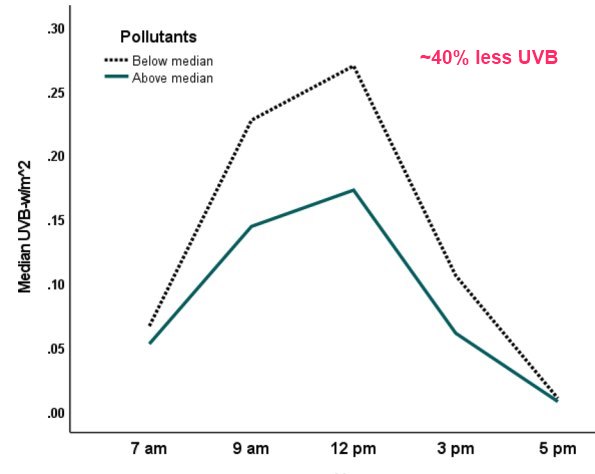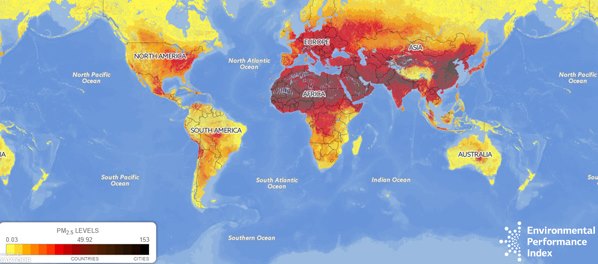Most air pollutions reduce Vitamin D (PM2.5 is worst)
Ambient Air Pollutions Are Associated with Vitamin D Status - June 2021
Int. J. Environ. Res. Public Health 2021, 18(13), 6887; https://doi.org/10.3390/ijerph18136887
Chenlu Yang 1 , Dankang Li 2 , Yaohua Tian 2 and Peiyu Wang 3,*
1 Department of Nutrition and Food Hygiene, School of Public Health, Peking University, No.38 Xueyuan Road, Beijing 100191, China
2 Department of Maternal and Child Health, School of Public Health, Huazhong University of Science and Technology, No.13 Hangkong Road, Wuhan 430030, China
3 Department of Social Medicine and Health Education, School of Public Health, Peking University, No.38 Xueyuan Road, Beijing 100191, China
Evidence on the effect of ambient air pollution on vitamin D is limited. This study aimed to examine the association of air pollution exposure with serum levels of 25-hydroxyvitamin D (25OHD) using UK Biobank health datasets. A total of 448,337 subjects were included in this analysis. Land Use Regression was applied to assess individual exposures to particulate matter with diameters ≤2.5 µm (PM2.5), ≤10 µm (PM10), nitrogen dioxide (NO2), and nitrogen oxides (NOx). Linear regression models evaluated the associations between air pollutants and serum vitamin D levels after adjustment of a series of confounders. All analyzed air pollutants were negatively associated with serum vitamin 25OHD levels. After adjusting for potential confounders, a 10 μg/m3 increase in concentrations of
PM2.5, PM10, NOx, and NO2 was associated with
−9.11 (95%CI: −13.25 to −4.97),
−2.47 (95%CI: −4.51 to −0.43),
−0.56 (95%CI: −0.82 to −0.30), and
−1.64 (95%CI: −2.17 to −1.10) nmol/L
decrease in serum vitamin 25OHD levels, respectively. Interaction analyses suggested that the effects of air pollution were more pronounced in females. In conclusion, long-term exposures to ambient PM2.5, PM10, NOx, and NO2 were associated with vitamin D status in a large UK cohort.
📄 Download the PDF from VitaminDWiki
Air pollutants are negatively associated with vitamin D-synthesizing UVB radiation intensity on the ground - Nov 2021
Scientific Reports volume 11, Article number: 21480 (2021)
Abdur Rahman & Abdirashid Elmi

Atmospheric levels of pollutants may reduce the UVB intensity at the earth’s surface, with a subsequent reduction in cutaneous vitamin D synthesis. We investigated the association of various pollutants with UVB intensity on the ground. Four-year data obtained from four weather stations from across Kuwait were analyzed by median regression.
Pollutants that were negatively associated with UVB were [β (95% CI)]: benzene [− 2.61 (− 4.13, − 1.09)], ethyl-benzene [− 2.20 (− 3.15, − 1.25)], ozone [− 0.23 (− 0.28, − 0.17)], nitric oxide [− 0.11 (− 0.15, − 0.06)], sulfur dioxide [− 0.10 (− 0.17, − 0.04)] and particulate matter PM10 [− 0.002 (− 0.003, − 0.002)].
Pollutants that were negatively associated with the UVB/UVA ratio were [β (95% CI)]: benzene [− 15.57 (− 24.94, − 6.20)], nitric oxide [− 0.53 (− 0.81, − 0.25)], ozone [− 0.38 (− 0.70, − 0.06)], and total hydrocarbon [− 0.02 (− 0.04, − 0.01)]. Furthermore, benzene and nitric oxide levels were higher in the morning and evening hours, which are the times of most solar exposure in this region due to high temperature during midday. In addition to other known factors, attenuation of UVB by these pollutants may contribute to lower vitamin D levels in populations. In addition to direct public health hazard, these pollutants may contribute to the very high prevalence of VDD in this region.
📄 Download the PDF from VitaminDWiki
VitaminDWiki - Air Pollution reduces Vitamin D production - many studies contains
{include}
And: Air pollution decreases Vitamin D levels (while pregnant in this case) – July 2022
VitaminDWiki - studies in both categories Deficiency and UV
This list is automatically updated
{category}
Real-time map of air quality levels around the world
Map of PM2.5 levels around the world

